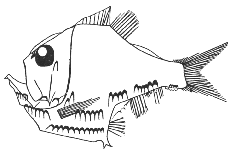Silver hatchetfish Argyropelecus aculeatus Cuvier and Valenciennes 1849
[Jordan and Evermann, 1896-1900, p. 604, as A. olfersi Cuvier, 1829.]

Figure 68.—Silver hatchetfish (Argyropelecus aculeatus). After Brauer.
Description—
This little fish is of so bizarre an appearance that once seen it could hardly be mistaken for any other species yet known from our Gulf, or for any that is likely to stray thither, unless one of its own tribe.[49] Its body is very thin sidewise, with its forward part a little less than three-fourths (70 percent) as deep as it is long from snout to base of tail fin, but with the ventral contour bending upward abruptly about midway of its length in characteristic contour, so that the rear half is much less deep than the forward half. This break in the ventral contour is marked by two short bony spurs, which are outgrowths from the pubic bones, and there is a short single spur (outgrowth from the pectoral arch) in front of them in the midventral line.
The eyes are large, so high up that the space between them on the top of the head is very narrow, and they are directed more upward than sidewise. The mouth is noticeably large, with wide gape, and it is so strongly oblique that the upper jaw is nearly vertical.[50] The tips of the two jaws are about even one with the other when the mouth is closed, and both jaws are armed with a large number of tiny sharp teeth. The dorsal fin is short, about midway of the fish, and of two parts, separated by a deep but short notch. The forward subdivision is in the form of a hard, triangular plate (apex rearward) supported by 8 or 9 hard spines, the rearmost of which is the stoutest and longest. The rearward subdivision is supported by 9 soft rays, that are bifid toward their tips. The adipose fin is long and low. The pectorals are as long as about two-fifths the greatest height of the body. The ventral fins, each with 6 soft rays, stand close behind the break in the ventral contour of the body, and they are connected with the anal fin by a thin transparent ridge. The anal, commencing about under the rear end of the base of the soft rayed part of the dorsal, is notched midway of its length; its forward part is supported by 7 rays close together, the rear part by 5 shorter rays spaced more widely. The caudal fin is forked. A noticeable feature is that the ventral edge of the deep forward part of the body, from the pectoral spur to the pubic spines, is sharp, with a series of 12 hard, plate-like scales or scutes, that extend for some distance up the sides, each slightly overlapping the next rearward, and the profile is saw-edged between the ventral and anal fins.
The hatchetfishes are provided with a complex system of conspicuous light-producing spots. The species aculeatus has one row of 12 very low down along each side of the deep forward part of the body; also, a second row higher up consisting of 6 in front of each pectoral fin, 2 along the base of the pectoral, 6 between pectoral and ventral fins, 4 between the ventral and the anal fins, 6 along the anal, and 4 very small ones between anal and tail fins. There is also one light-organ a little below and behind [page 150] each eye, 2 on the lower part of the gill cover on each side and about 5 on the lower jaw on each side.
Color—
Perhaps the most conspicuous feature of the hatchetfishes, as taken from the water, is that their entire bodies are glistening silvery. On some specimens the silver is underlaid with velvet black over the trunk as a whole; on others the black under pigment is confined to a marginal band, broader or narrower. The luminescent spots are pale yellow or white.
Size—
Maximum length probably not more than 3 inches or so.
Range and occurrence in the Gulf of Maine—
All the members of this genus are oceanic, and inhabit the mid-depths. Localities listed by Schultz[51] for this species include the Grand Banks, between Georges and Browns Banks, and the offing of New Jersey and Virginia in the western Atlantic; the Gulf of Mexico; West Indies; off the South African coast; the Indian Ocean; and the Philippines. Our only reason for mentioning the hatchetfish is that one specimen was taken on August 31, 1883, by the Albatross between Georges and Browns Banks where the depth was 144 fathoms.[52]
[49] The several known species of Argyropelecus resemble one another so closely that their identification calls for a specialist. They have been reviewed by Schultz, Proc. U. S. Nat. Mus., vol. 86, 1938, pp. 147-153. The most detailed description of this particular hatchetfish, with the best illustration (copied here as fig. 68) is by Brauer, Wiss. Ergeb. Deutschen Valdivia Tiefsee-Exped., vol. 15, Pt. 1, 1908, p. 110, fig. 47.
[50] Most of the published illustrations of Argyropelecus fail to show this.
[51] Bull. U. S. Nat. Mus., vol. 86, 1938, pp. 146-147 and pp. 151-152.
[52] Albatross station 2063, lat. 42° 23' N., long. 66° 23' W. This specimen was recorded by Goode and Bean (Smithsonian Contrib. Knowl., vol. 30, 1895, p. 127) as A. olfersii. But Schultz (Proc. U. S. Nat. Mus., vol. 86, 1938. p. 151) has found on reexamination, that it is an aculeatus.